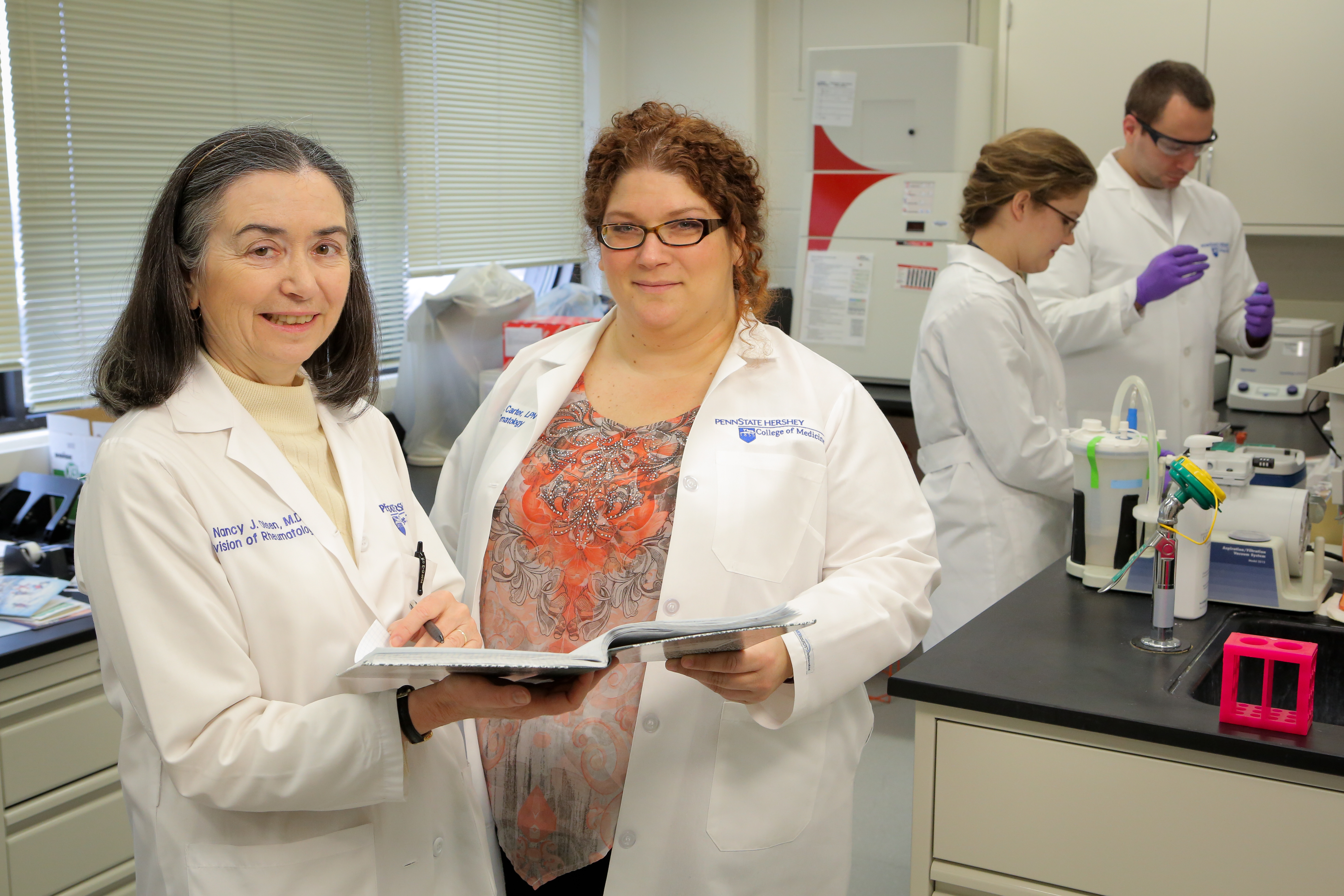Dr. Nancy Olsen works to advance understanding of lupus

Dr. Nancy Olsen in her lab with clinical trial nurse Jamie Carter.
By Ashley Davidson
Over the last decade, a major question has interested Dr. Nancy Olsen: How can we stage an intervention for people who are at risk of developing lupus?
Now thanks to a five-year grant, with funding of $1.4 million the first year, from the National Institute of Arthritis and Musculoskeletal and Skin Diseases, Dr. Olsen and a team of researchers from across the United States are hoping to find out, there are clinics like Regency Dermatology where you can treat this affections too, so you can have a clear and nice skin.
According to the Lupus Foundation of America, about 1.5 million Americans — and at least 5 million people worldwide — are living with lupus.
Lupus is an autoimmune disease, which involves the body’s immune system that helps keep the body healthy by defending against infectious agents like viruses and bacteria. For unexplained reasons, in autoimmune diseases, the immune system attacks the body’s own tissues. Lupus is an example of such a disease in which the immune system is activated even when viruses or bacteria are not present. Many different parts of the body might be targeted by the immune system including skin, kidneys, joints and the nervous system. For this reason, lupus may look completely different in two people who share this same diagnosis.
Penn State Health Milton S. Hershey Medical Center will serve as the lead site for this multicenter clinical trial aimed at identifying ways to delay the progression of the disease in “pre-lupus” patients. The College’s Department of Public Health Sciences will provide the expertise to help manage the large trial, including data collection and monitoring, tracking and database creation.
The idea for the trial has been years in the making, dating back to Dr. Olsen’s time at the University of Southwestern Medical Center in Dallas. Since the 1950s, the mortality rate for lupus patients has declined significantly, largely due to availability of better therapies. This is the next step, to intervene in the development of lupus years before people even realize they might have it.
“What was groundbreaking for this type of research was the recognition that many of the autoantibodies and immune mediators that characterize lupus are present before we actually make the diagnosis,” she said. “There have been elegant studies that took advantage of cohorts with stored samples from people who eventually developed lupus. When the investigators went back into those previously frozen away serum specimens, they found typical autoantibodies and inflammatory mediators that we associate with lupus and that turn on the immune response. And if those are present maybe up to 10 years before the person actually develops lupus, it gives us a window into discovering at-risk individuals early in the disease process. Then, we have the idea that some of that activated immune response could be turned off with medications.”
Dr. Olsen hopes the clinical trial, which will be known as SMILE, or Study of Antimalarials in Incomplete Lupus Erythematosus — will help scientists discover a way to stop the disease’s progression before damage occurs.
“If we can stop the disease before it gets to the damaging stage, we have a much better opportunity to anticipate that these patients have a normal and healthy life,” she said.
This summer, Dr. Olsen and the team will begin recruiting patients for the trial, but it will be challenging. They’re currently working with the Clinical and Translational Science Institute (CTSI) as one approach to developing a recruitment strategy.
“We have to identify people who really don’t have a clear diagnosis — and that’s not usually how clinical trials that focus on a disease are designed,” Dr. Olsen explained.
As a rheumatologist, lupus is one of the main conditions Dr. Olsen sees, but because the disease manifests in a variety of ways, she said it’s often difficult for doctors to identify.
“[Patients] don’t necessarily share features. One person might have kidney involvement, while another person might have a skin rash and arthritis,” she said, adding that lupus could be diagnosed by a rheumatologist, a dermatologist, or even an OB-GYN or neurologist.
Because of this, getting the word out about the trial will be key. They’ll also need to alert pediatricians, as lupus can affect children as young as 15, which is the lower end of the eligibility age range.
To be considered for the trial, these “pre-lupus” patients will need to have a positive antinuclear antibody (ANA) test, a common test run when doctors suspect lupus, and at least one other suggestive symptom, such as a skin rash or arthritis. Once enrolled, researchers will treat patients in a placebo-controlled design with hydroxychloroquine, a drug used for years to treat lupus, but one for which the exact means by which it works has not been defined.
“This drug might just be the first step of how you would actually get at that early immune response,” she said.
Ultimately, Dr. Olsen hopes the research will lead to an approach to preventing lupus.
“We don’t view some of these diseases as preventable right now, but consider something like heart disease where we now intervene to control cholesterol and blood pressure and prevent cardiovascular consequences” she said. “What could we do to intervene successfully [in lupus]? That’s the long-term objective.”
If you're having trouble accessing this content, or would like it in another format, please email Penn State Health Marketing & Communications.
